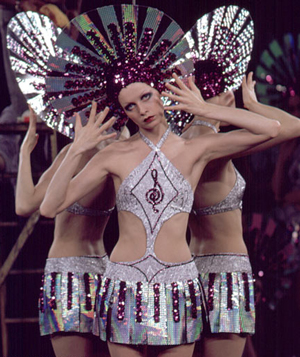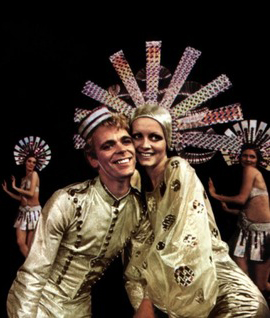
 |
|
|
|
The creative film director Ken Russell has a devoted following that loves everything he ever filmed, from a series of 1960s TV shows about great artists to his intriguing drama Women in Love to his series of phantasmagorical musical biographies. Russell built a definite Bad Boy reputation as the director of the X-Rated The Devils, an excessively violent, graphic and blasphemous period epic. 1971's The Boy Friend is a spirited, G-rated musical filmed immediately after The Devils. Russell's star is Twiggy, the famous '60s teen model, and she's terrific in her screen debut. Twiggy's slight build, huge, sad eyes and winning smile are perfect; she also sings and dances quite well. 
Sandy Wilson's original 1954 stage musical lampooned the peppy, romance-oriented (and shallow) variety entertainments from 1920s England. Julie Andrews made her American stage debut when this popular show came to Broadway. Perhaps inspired by Singin' in the Rain, the play is a feather-weight trifle about a number of young schoolgirls at the "Villa Caprice" getting ready for an important party. Polly Browne, a millionaire's daughter, has no beau of her own and hides her posh background when Tony, a delivery boy, takes an interest in her. Polly's doubts vanish when Tony shows up as expected; the other girls all receive proposals of marriage but determine to wait until midnight to give their answers. Viewers unfamiliar with the style of '20s English musicals spoofed in The Boy Friend might remember a snippet from one presented in David Lean's A Passage to India. The generic image is a quartet of gaily-dressed ingenues carrying parasols, courted by young swains in ice cream coats and straw skimmer hats. In Lean's movie, the serious Judy Davis can't stand the inane amateur production and walks out. Backed by the considerable resources of EMI-MGM, Ken Russell's frames the play The Boy Friend as a show being offered by a run-down theatrical company fraught with all the shenanigans expected in a backstage comedy. Frantic, nervous understudy Polly (Twiggy) fills in when the show's star (Glenda Jackson, in a cute cameo) hurts her leg. Russell even goes so far as to directly quote the deathless "Come back a star!" and the "Go out there and make me hate you!" cliché dialogue from the original Busby Berkeley backstage extravaganza 42nd Street. The staging and performances of the "realistic" musical numbers remain fairly faithful to what might be seen on a stage in 1925, augmented with charming and lovely designs (Tony Walton) and terrific costumes (Shirley Russell). But Russell doesn't stop there. Several of the musical numbers "open up" into surprising fantasy sequences, each following a different visual theme. One romp in a park is an orgy by characters from Greek mythology; it doesn't sound too promising but is as clever and pretty as the corresponding animated scene in Disney's Fantasia. "A Room In Bloomsbury" opens up for Polly and her beau Tony (Christopher Gable of The Music Lovers and Women in Love) to play house in an outsized dollhouse set. They then leave the stage even farther behind, to romp through a forest of mushrooms in a fanciful land of trolls and elves. 
Many of the fantasies reproduce iconic images from '30s musical classics. We see the showgirls riding the wings of a giant biplane "Flying Down to Rio", for instance. Many recreate Busby Berkeley's gloriously outrageous musical set pieces choreographed for the camera in his major Depression-era musicals. We get Berkeley's complex silhouette tricks and his aerial views of dozens of dancers creating kaleidoscope-like geometric patterns. Shimmering in unusual colors, female bodies form a screen-full of playing cards. A railroad car splits in two as in "Shuffle off to Buffalo"; the camera plows through dozens of splayed legs to reveal the romantic leads smiling at the camera. In 1971 the camp rediscovery of Busby Berkeley hadn't quite filtered down from the New York smart set to college campuses, so most audiences were taken by surprise. Russell also didn't cheat, in that he created his graphic illusions with the same organic methods Berkeley used. These hommages are more than copycat exercises -- design-wise, some are refinements on Berkeley's originals. Russell's syncopated chorines show themselves to be better dancers than Berkeley's squads of exhausted Hollywood showgirls. It also needs to be said that Russell and his designers and choreographers come up with scores of arresting dance and performance inspirations on their own -- the creativity on display in The Boy Friend is dazzling. Unlike the Rodgers & Hammerstein operetta + ballet musicals that had dominated screens for fifteen years The Boy Friend entertains through pure performing oomph -- those four key "girlfriends" are terrific dancers and comediennes. Tommy Tune's long-legged specialty dancer is a perfect match for the kind of tap-dancing wonders that emerged from New York's vaudeville circuit. 
While Polly's desperately tries to attract Tony's attention (and avoid laying an egg), most of the other performers are busy upstaging and sabotaging each other in an attempt to impress Mr. De Thrill (Vladek Sheybal), a big time movie director watching the sparsely attended matinee performance. One of the male performers is hiding from his wife, who shows up with a crying baby in tow. An older veteran rails about the indignities of working in the tiny theater, while his wife tries to cheer him up. Poor Polly is convinced that Tony doesn't really like her, but the backstage romance and the one in the play eventually dovetail into the expected happy ending. The Boy Friend was chopped up for distribution, with the original US release coming out in 70mm but with almost twenty minutes of cuts. We're told that Russell's full-length 136-137 minute version wasn't shown in the states until the late 1980s. The fact is that the movie does drag somewhat in the last act. We begin to overdose on fantasy sequences, especially when Russell repeats his overhead pinwheel effect, or throws in a second solo number with Twiggy singing another Nacio Herb Brown MGM tune from the late 1920s. Just the same, the overall effect is not diminished and the hardcore Russell crowd was surely pleased. We come away from The Boy Friend enchanted by Twiggy, and angry that the movie industry in 1971 didn't find more special opportunities for her. Twiggy's filmography is not a lean one but it contains nothing as impressive as this first film. Most younger viewers probably know her from her charming cameo in The Blues Brothers, and must look to their elders to find out how big she was just ten years earlier. Plenty of visually oriented high-concept films, musical and otherwise, have failed for lack of a strong central star performance, and Twiggy makes The Boy Friend into a classic. 
The Warner Archive Collection's DVD-R of The Boy Friend is a keeper. The enhanced widescreen transfer displays the full horizontal sweep of the images, perfectly framing cameraman David Watkins' carefully composed images. The colors are exceptionally good, especially the subtle use of greens and yellows. The "traditional" stage scenes give a good impression of the footlights shining up on all the exaggerated smiles of the heavily made-up comediennes. After twenty minutes we're thinking, "Where's the Blu-ray of this dazzler?", but the DVD-R looks great. The Dolby Digital stereo (2.0?) track is excellent, but we regret the lack of subtitles -- much of the dialogue is delivered fast and in dialect, and we miss a lot of lines ... although what's happening is too obvious for confusion to result. The full 136-minute cut includes entire musical numbers and plenty of stage business dropped from the original American cut. We're told that the added fantasy sequences in "A Room in Bloomsbury" were restored -- they must amount to four or five minutes in themselves. The show also has an Intermission card and musical accompaniment dropped for the initial U.S. run. No trailer is included but the WAC makes an exception to its usual policy and includes a 1971 behind the scenes featurette showing Russell at work filming the dancers on stage. It's a real treat. We readily understand when Russell fans explain that The Boy Friend needs to be seen on a large screen. I have to say that in a home theater situation, this quality DVD-R serves very well. I tried only once before to see the show pan-scanned on television, and quickly gave up the idea. This screening was a knockout.
On a scale of Excellent, Good, Fair, and Poor,
The Boy Friend rates:
Reviews on the Savant main site have additional credits information and are often updated and annotated with reader input and graphics. Also, don't forget the 2010 Savant Wish List. T'was Ever Thus.
Review Staff | About DVD Talk | Newsletter Subscribe | Join DVD Talk Forum |
| ||||||||||||||||||